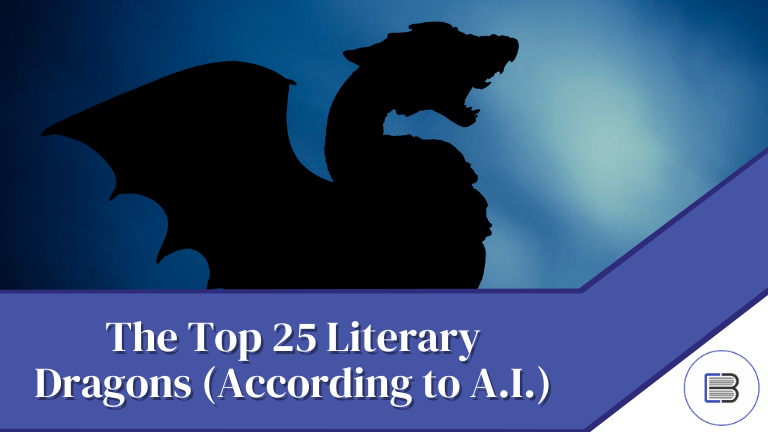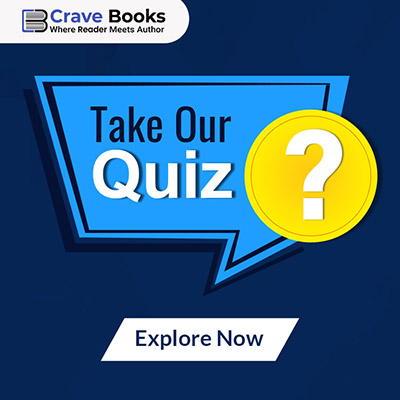We let AI take a crack at ranking the top 25 most legendary dragons in literary history, pulling from the last 100 years of fiction.
The results?
A wild mix of fire-breathing tyrants, wise mentors, and even a few unexpected underdogs (looking at you, Errol 🐉💨).
So, do you agree with this ranking, or did AI totally miss the mark? Share this post with your fellow bookwyrms!
#25. The Last of the Dragons – The Last of the Dragons (Edith Nesbit, 1925) – This whimsical dragon is more tired than fearsome. As the last of his kind, he defies expectations by refusing to fight knights and instead becomes a friendly pet to a princess. Eventually transformed into the first airplane, this quirky dragon earns a spot for subverting fairy-tale tropes and marking a charming end to the age of legendary dragons
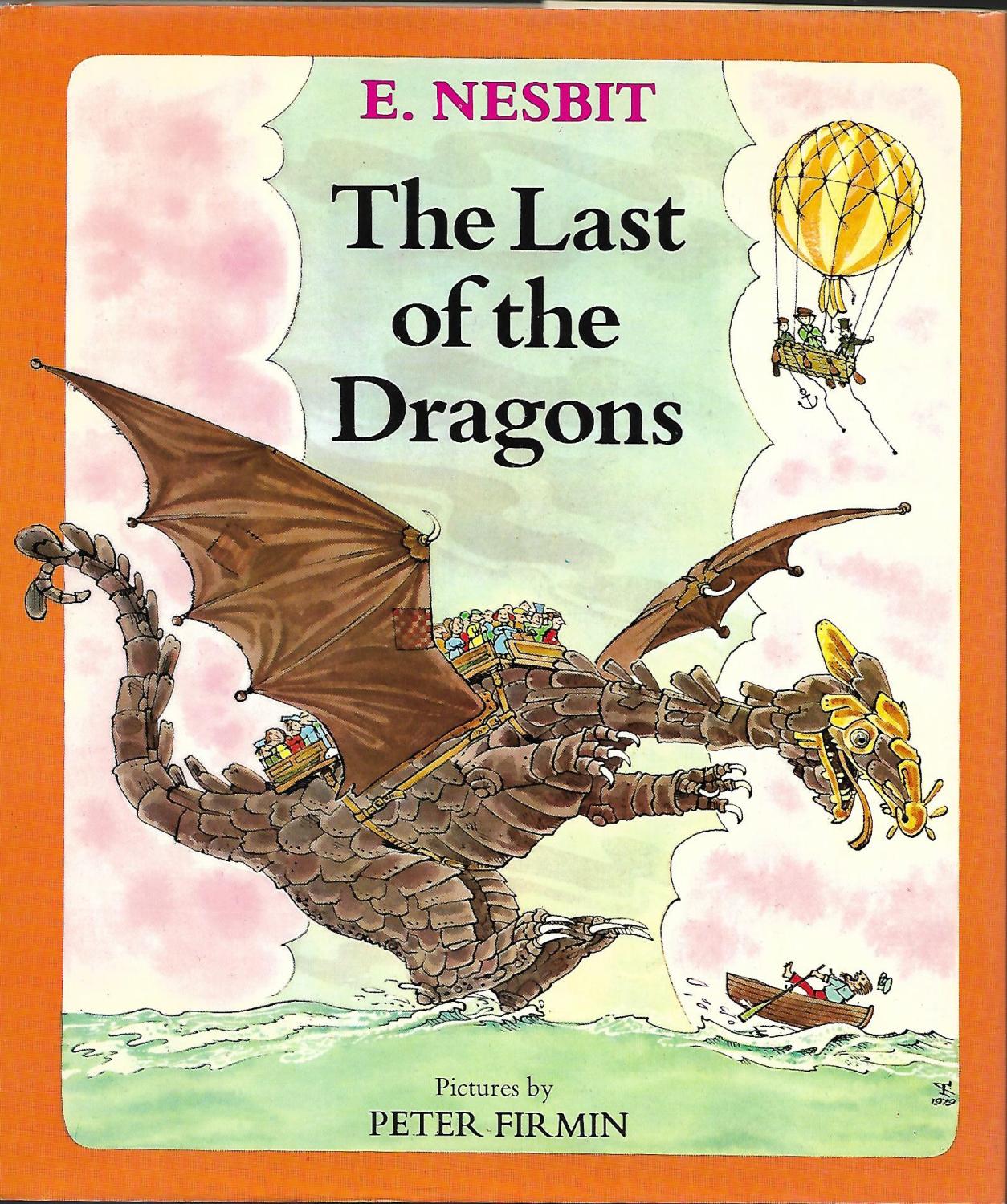
#24. The Paper Bag Princess’s Dragon – The Paper Bag Princess (Robert Munsch, 1980) – A classic children’s tale flips the script with a vain, fire-breathing dragon outsmarted by Princess Elizabeth. After burning down her castle and clothes, this dragon is lured into exhausting himself by showing off his full flying and fire-breathing skills. Though unnamed, he’s memorable for his role in a feminist twist on the genre – proving even a fearsome gold-hoarding dragon can be defeated by brains over brawn.
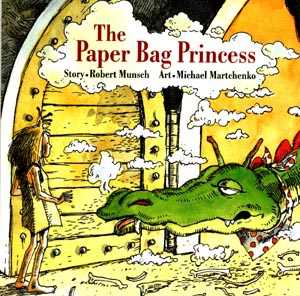
#23. “Sir Isaac Newton” – Between Planets (Robert A. Heinlein, 1951) – In a sci-fi spin, Heinlein introduces highly intelligent Venusian “dragons” who befriend humans. One such dragon adopts the nickname “Sir Isaac Newton,” highlighting his scientific aptitude and friendly nature. He’s not a traditional fire-breather, but his warm personality and genius-level intellect influenced later portrayals of dragons as wise allies rather than monsters.

#22. Eustace Scrubb (Dragon form) – The Voyage of the Dawn Treader (C.S. Lewis, 1952) – When peevish Eustace is turned into a dragon as punishment for his greed, it becomes a defining moment in this Narnia adventure. As a dragon, Eustace is miserable and lonely, learning humility until he’s “undragoned” and redeemed. His brief dragonhood isn’t badass in power, but it’s legendary as a moral lesson – showing that inner treasure matters more than hoarded gold.

#21. The Hungarian Horntail – Harry Potter and the Goblet of Fire (J.K. Rowling, 2000) – Arguably the most notorious dragon in modern YA, the Horntail is a spiked, ferocious beast Harry must face in the Triwizard Tournament. With an immense wingspan and a fire-breathing range of up to fifty feet, this dragon pushes our young hero to his limits in an iconic high-flying battle. The Horntail makes the list for its cultural impact – introducing a generation to dragons’ terrifying thrill in one of HP’s most gripping scenes.
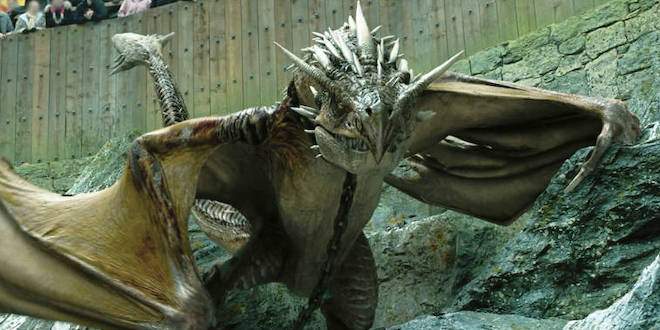
#20. Clay (MudWing) – Wings of Fire: The Dragonet Prophecy (Tui T. Sutherland, 2012) – Clay is a heroic young dragon who helped make this series a phenomenon among middle-grade readers. As a gentle MudWing who’d rather protect friends than fight, Clay’s warmth and bravery win hearts. He’s not the fiercest of his group, but his story – dragons as complex protagonists with destinies – inspired countless kids, proving modern dragons can be noble heroes in their own right.

#19. Errol (Swamp Dragon) – Guards! Guards! (Terry Pratchett, 1989) – Small, ill-tempered, and prone to explosive indigestion, Errol is the comically endearing swamp dragon of Discworld. He’s no giant wyrm – in fact, he’s about the size of a dog – but Pratchett uses Errol to hilariously undermine dragon tropes. Despite his tiny stature, Errol’s moment of glory (rocket-powered flight to save the day) earns him a spot for sheer lovable oddity and the fresh air he brought to fantasy’s dragon lore.
#18. Kazul – Dealing with Dragons (Patricia C. Wrede, 1990) – As a dragon who’d rather chat than charbroil princesses, Kazul modernized dragons in YA fantasy. She’s wise, no-nonsense, and even becomes the Dragon King (a title of rank, not gender) in an amusing twist. Kazul’s partnership with Princess Cimorene – trading tea and logic instead of fire and blood – made her influential as a portrayal of dragons as nuanced characters. Her reign in the Enchanted Forest is quietly legendary among ’90s fantasy readers for showing a dragon can rule with wit and reason.

#17. Chrysophylax Dives – Farmer Giles of Ham (J.R.R. Tolkien, 1949) – From the pen of Tolkien comes this sly, comedic dragon whose greed is matched only by his guile. Chrysophylax ravages the countryside until a reluctant farmer bests him, whereupon this “precious” worm offers a crafty mix of cowardice and courtesy to save his scaly hide. While not as famous as Smaug, Chrysophylax earns his spot for his delightful personality – a pompous, treasure-laden dragon who influenced humorous fantasy and showed that even the great Tolkien had a playful side to dragon lore.

#16. Tairn – Fourth Wing (Rebecca Yarros, 2023) – One of the newest dragons to capture readers’ imaginations, Tairn is a massive, battle-scarred beast bonded to a fledgling dragon rider in this breakout novel. He’s brutally powerful and brutally honest – with a dry wit that steals every scene. Tairn’s protective fury and grudging respect for his rider helped Fourth Wing soar in 2023, proving that even in the 2020s a dragon can take fantasy by storm and become an instant fan-favorite.

#15. Toothless – How to Train Your Dragon (Cressida Cowell, 2003) – Originally a small disobedient dragon in the books, Toothless became iconic through adaptation as the sleek Night Fury. In print or on-screen, Toothless symbolizes the new millennium’s dragon-as-best-friend. Playful yet formidable when it counts, he forges a deep bond with Viking boy Hiccup. Toothless’s popularity revitalized dragon love for a new generation, showing that a dragon can be utterly adorable yet still downright awesome in a fight.

#14. Villentretenmerth (Borch Three Jackdaws) – The Witcher series (Andrzej Sapkowski, 1992) – A rare golden dragon who can assume human form, Villentretenmerth is a figure of wisdom and mystery in The Witcher. Disguised as the worldly Borch Three Jackdaws, he tests heroes’ morals and eventually reveals himself during a dragon hunt. This shape-shifter earns his legend by choosing to live among humans and even protect them – a tolerant trait “unlike the rest of dragonkind”. His clever reveal and honorable nature left a deep impression on fantasy fans, blending Slavic folklore with modern storytelling.
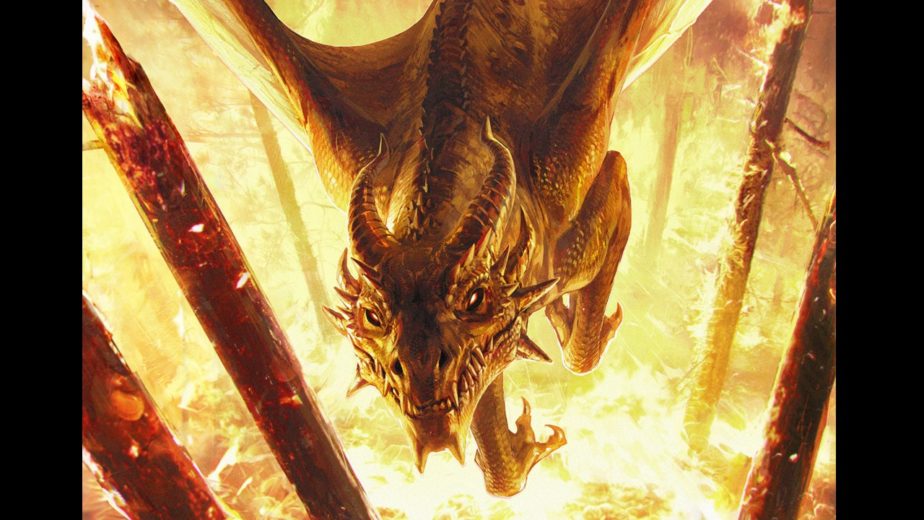
#13. The Nameless One – The Priory of the Orange Tree (Samantha Shannon, 2019) – An ancient, colossal wyrm of pure malice, The Nameless One is the ultimate draconic evil of the modern era. A “fearsome western dragon” of fire and venom, he once spread a devastating plague until he was defeated and sealed away in myth. When this behemoth finally rises, the devastation is biblical. His inclusion here nods to how this bestselling epic rekindled high fantasy’s love for dragon-driven conflict – a direct “feminist retelling” of the St. George legend with a world-ending dragon at its core.

#12. Morkeleb the Black – Dragonsbane (Barbara Hambly, 1985) – Sinister, ancient, yet oddly sympathetic, Morkeleb is a dragon who embodies the shift to more complex fantasy villains. He begins as the near-invincible target of a dragon-slaying quest, an incarnation of dark magic and greed. But Hambly gives Morkeleb a voice and a tragic dignity, foreshadowing the nuanced dragons to come. His tense duel with the hero John Aversin – and the surprising respect Morkeleb shows to the sorceress Jenny – made him an unsung influence on later dragons that blend menace with melancholy.

#11. Ancalagon the Black – The Silmarillion (J.R.R. Tolkien, 1977) – The largest dragon ever to haunt Middle-earth, Ancalagon is less a character than a cataclysm. Summoned by Morgoth in the First Age, this winged behemoth was so gigantic that his fall broke the peaks of Thangorodrim. Tolkien notes Ancalagon as “the largest dragon of Middle-earth”, and his fiery rampage required an entire army of Eagles and a half-elven hero to stop. Whenever fans debate the biggest, baddest drake of all time, this jet-black terror’s name inevitably comes up – his sheer scale set an almost unbeatable benchmark for dragonkind.

#10. Andarna – Fourth Wing (Rebecca Yarros, 2023) – A golden, feathertail dragon, Andarna is bonded to Violet Sorrengail, making Violet the first rider ever to bond with two dragons. Despite her smaller size, Andarna possesses the rare ability to manipulate time, allowing her to momentarily freeze it—a power that proves invaluable in critical moments. Her unique abilities and the unprecedented nature of her bond with Violet add depth to the dragon lore within the Empyrean series, showcasing that even less imposing dragons can wield extraordinary power.

#9. Ramoth – Dragonflight (Anne McCaffrey, 1968) – As the great golden queen of Pern, Ramoth ushered in the age of dragonriders. Telepathically bonded to her rider Lessa, Ramoth is massive, commanding, and fiercely protective – the mother of an entire weyr of dragons. McCaffrey’s Dragonriders of Pern merged sci-fi and fantasy, and Ramoth’s presence at the heart of it gave us a dragon society like no other. Her influence echoes in every later story featuring dragon riders or human–dragon bonds, from Eragon to Temeraire. Ramoth earns her rank for defining what it means to be a dragon queen and for inspiring generations to dream of soaring on dragonback.
#8. Glaurung – The Silmarillion (J.R.R. Tolkien, 1977) – The Father of Dragons in Tolkien’s legendarium, Glaurung is as devious as he is destructive. This first dragon – a vast, wingless fire-drake – crawls from the pits of Angband to sow dread across the First Age. Not only does he lay waste to kingdoms, but with cruel cunning he bewilders and curses the hero Túrin Turambar, orchestrating one of the darkest tragedies in fantasy. Glaurung set the template for intelligent, malevolent worms in modern fiction, bridging the gap between ancient dragon myths and fully realized literary villains.

#7. Temeraire – His Majesty’s Dragon (Naomi Novik, 2006) – What if dragons fought in the Napoleonic Wars? Temeraire, a rare Celestial dragon, answers that with style and intellect. Hatched and bonded with Captain Will Laurence, Temeraire combines the fierce power of a heavyweight combat dragon with the curiosity of a scholar (he even debates his own rights and status). Novik’s wildly imaginative series brought dragons into the heart of alternate history, and at its heart is Temeraire’s loyal, principled personality. His impact lies in showing that even amid musket and cannon fire, a dragon can be a best friend and comrade – adding heart to the genre and reinvigorating dragons for the 21st century.

#6. Kalessin – The Farthest Shore (Ursula K. Le Guin, 1972) – Called “the Eldest,” Kalessin is the ancient king of Earthsea’s dragons. More than just a gigantic fire-breather, Kalessin possesses ageless wisdom and a mystic bond to the world’s creation. When he finally appears, it’s a breathtaking climax – he carries a human wizard on his back and even has the power to grant a form of immortality. Le Guin’s dragons grow from greedy to godlike across her saga, and Kalessin is the pinnacle of that evolution: serene, terrifying, and embodying the very soul of magic. Few dragons in literature feel as truly legendary as Kalessin, who is often hailed as one of fantasy’s most awe-inspiring dragons.

#5. Saphira – Eragon (Christopher Paolini, 2003) – Proud, blue-scaled, and bonded by heart and mind to the young Rider Eragon, Saphira became the face of 2000s dragon fantasy. She’s a warrior, confidante, and mentor all in one – often wiser than her teenage rider. Together they sparked a bestselling series that introduced millennial readers to classic dragon-rider lore in a fresh way. With her fiery combat prowess and fiercely loyal personality, Saphira brought dragons roaring back to the bestseller lists, inspiring a new generation to dream of bonding with a dragon and fighting tyranny from dragonback.
#4. Falkor – The Neverending Story (Michael Ende, 1979) – A luckdragon with pearly scales and a canine grin, Falkor is the epitome of benevolent dragonkind. He’s no brute but a wise, eternally optimistic friend to the hero Atreyu. Falkor’s jubilant flight and rescue of Bastian in both book and film made him one of the most beloved dragons ever. Culturally, he proved that dragons could be symbols of hope and companionship, not just destruction. Riding on Falkor’s back, generations of readers (and viewers) felt the pure joy of fantasy – and who hasn’t secretly wished for a luckdragon of their own?

#3. Tiamat (Queen Takhisis) – Dragonlance Chronicles (Margaret Weis & Tracy Hickman, 1984–85) – Five-headed and fearsome, Tiamat (known as Takhisis on Krynn) is the ultimate dragon villainess. This Dragon Queen is literally a goddess of evil in the form of a gargantuan multi-headed dragon – each head a different color, each breathing its own deadly magic. As the final antagonist of the popular Dragonlance saga, she left an indelible mark on 1980s fantasy fans. Tiamat’s multi-headed fury and lofty titles (“Queen of Evil Dragons, Nemesis of the Gods”) cemented her as a cross-media icon (from D&D games to novels). No list of legendary dragons would be complete without this embodiment of draconic chaos and tyranny.

#2. Drogon – A Song of Ice and Fire series (George R.R. Martin, 1996) – The fiercest of Daenerys Targaryen’s three dragons, Drogon revived the awe of dragons for a modern audience. Born from petrified eggs and fire, he grows from a hatchling in 1996’s A Game of Thrones to a colossal black-red wyrm by later books. Drogon’s ferocity – from burning armies to descending on an arena – gave Game of Thrones its most jaw-dropping moments and brought high fantasy roaring into the mainstream. In the novels (and an even bigger pop-culture footprint via HBO), this “ferocious” winged beast became the defining dragon of the 21st century, as majestic and untamable as a living flame.

#1. Smaug – The Hobbit (J.R.R. Tolkien, 1937) – The definitive modern dragon, Smaug is “a most specially greedy, strong and wicked worm,” slithering atop a stolen mountain of gold. Cunning and vain, he psychologically toys with Bilbo Baggins in one of literature’s tensest dialogues – all while ready to blast fire at the slightest provocation. Smaug’s fiery wrath against Lake-town and iron-scaled invulnerability (save that infamous weak spot) set the standard for dragon magnificence in fantasy. From his hypnotic speech to his devastating flames, Smaug embodies the ultimate dragon archetype. Generations of readers have been spellbound by Tolkien’s “extraordinary villain”, making Smaug the most legendary and badass dragon of the last century.

Want to find your dragon type?
